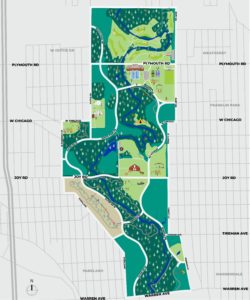 Rouge Park: DAS Initiative
Rouge Park: DAS Initiative
McKenna Sabon, A. Alfred Taubman College of Architecture + Urban Planning
Collaborators: Aracely Landero and Kevin Michael Luciw Bechard, A. Alfred Taubman College of Architecture + Urban Planning; Elizabeth Bigham, School of Information
Rouge Park: DAS Initiative aims to increase Rouge Park’s user diversity, accessibility, and stewardship by providing information to various user groups and connecting them with activities and amenities suitable for their interests through an interactive, web-based map. In the process, we will analyze the existing conditions of the park to offer recommendations and insight for future development. We expect the website to be completed by May 2022. Our interests lie in creating positive social impacts through design. The project allows us to target a pressing community need and work collaboratively with various disciplines and organizations. It will further help us acquire knowledge in community-based design, spatial planning, and conceptual development.
We are collaborating with Huron-Clinton Metroparks and Friends of Rouge Park to develop Rouge Park: DAS Initiative. We are excited to have both a city partner and community partner involved in this project, and are confident in our ability to produce a deliverable that would benefit the partners and the overarching community. Using the Adobe Creative Suite, we are illustrating the park’s amenities, physical characteristics, and history to visually engage users through the website. We are also working closely with our mentor, Anya Sirota, for review and guidance on our progression. Being that the final product is an interactive web-based map, we are partnering with Elizabeth Bigham, a School of Information senior majoring in User Experience, to develop the website. In addition, we have partnered with Kevin Bechard, an M.LARCH student, to collaborate with us on analyzing the existing ground conditions and flora at Rouge Park. We are excited to work collaboratively with Elizabeth and Kevin and how our differing educational experiences and skills will strengthen our project. As architecture students, we have the knowledge, tools, and methods to engage, alongside others, in design processes. Our design, collaboration, and management skills will be effective in the execution of this project. In addition, we will be analyzing the effectiveness of the existing park programs and connectivity, which are skills we both acquired in our education through the University of Michigan.
Through the combination of elements of landscape design, web design, and art installation, our project has the capability to strengthen the role of public engagement in the stewardship of civic infrastructure. We believe this project will augment interaction with Rouge Park and its landscape and ultimately lead to community-wide appreciation and accessibility of the park.
